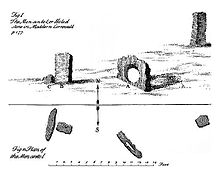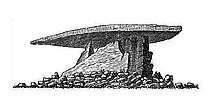William Borlase
William Borlase (born February 2, 1695 in Pendeen , Cornwall ; † August 31, 1772 ) was an English archaeologist and naturalist and came from an old Cornish family, which extended their ancestry to the time of the Norman conquest of England in 1066 by William I. could lead back. The French ancestors were originally called Taillefer , but, as was customary at the time, called themselves Borlâs after the area in which they settled in Cornwall .


Life
Borlase studied at Exeter College , Oxford and was ordained a priest in 1719 . From 1722 he looked after the parish church of Ludgvan and in 1732 also took over the parish of St Just . This area in the former Penwith District of Cornwall was known for its copper deposits , which were brought to light in an intensive mining process , as well as numerous fossils and minerals . Borlase started a collection and began studying the county's prehistory and early history .
In 1750 Borlase was elected a member of the Royal Society . In 1754 he published his first work, Antiquities, historical and monumental, of the County of Cornwall , in which he wrote that he was dealing with the antiquities of his country, since he could not travel to Greece. Observations on the Ancient and Present State of the Islands of Scilly, and their Importance to the Trade of Great Britain followed in 1756 . In 1758 Borlase published the Natural History of Cornwall . In 1769 Bowyer and Nichols in London published the second supplemented and expanded edition of Antiquities, historical and monumental, of the County of Cornwall .
Borlase furnished all of his works with self-made etchings . These include early pictorial representations of the following well-known megalithic systems :

Borlase exhibited at the Ashmolean Museum in Oxford a variety of fossils and artifacts that he had found in Cornwall and described in his works. In gratitude, he was awarded a doctorate by the university .
Borlase knew most of the leading writers of the period personally. He maintained regular correspondence with Alexander Pope for a long time and provided most of the fossils and minerals for his artificial grotto in Twickenham . Borlase was also in close contact with the Welsh zoologist and archaeologist Thomas Pennant .
Fonts
- Antiquities, historical and monumental, of the County of Cornwall , Oxford 1754
- Observations on the Ancient and Present State of the Islands of Scilly . Oxford 1756
- The Natural History of Cornwall . Oxford 1758
- Antiquities, historical and monumental, of the County of Cornwall . 2nd edition, Bowyer and Nichols, London 1769
Web links
Individual evidence
- ^ West Penwith Resources - S. Just in Penwith (Lake 3). In: west-penwith.org.uk. March 16, 2005, accessed January 3, 2015 .
- ↑ a b Borlase, William . In: Encyclopædia Britannica . 11th edition. tape 4 : Bishārīn - Calgary . London 1910, p. 255 (English, full text [ Wikisource ]).
- ^ Herbert Kühn: History of Prehistory Research. Walter de Gruyter, 1976, ISBN 978-3-11-005918-2 , p. 28. Limited preview in the Google book search
- ^ West Penwith Resources - S. Just in Penwith (Lake 3). In: west-penwith.org.uk. March 16, 2005, accessed January 3, 2015 .
- ↑ William Borlase. UNL libraries
- ^ Thomas Pennant: Letter from Thomas Pennant to Rev. (William) Borlase. 1763, accessed January 3, 2015 .
| personal data | |
|---|---|
| SURNAME | Borlase, William |
| BRIEF DESCRIPTION | English ancient and natural scientist |
| DATE OF BIRTH | February 2, 1695 |
| PLACE OF BIRTH | Pendeen , Cornwall |
| DATE OF DEATH | August 31, 1772 |
